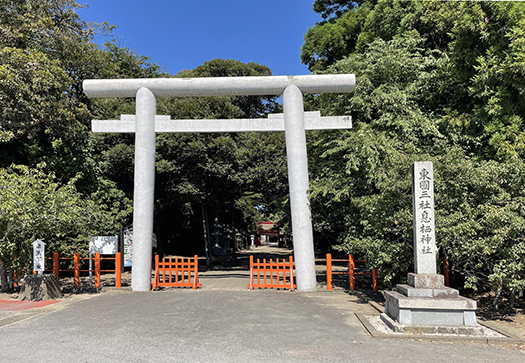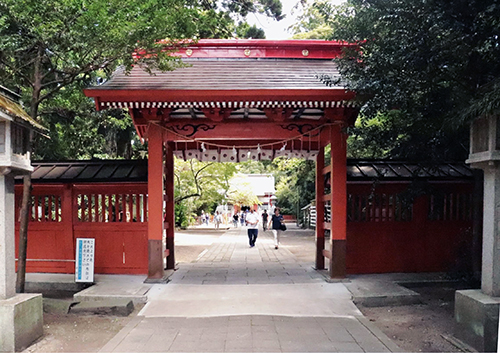


息栖という神社名の由来についてもう少し考えて見たい。
「栖」という文字は鳥の巣、ねぐらというような意味合いの文字なのだという。そうだとするとこれは漢字的な「意味」からの命名だろうと確定して考えることができるのではないか。
そして一般的に2文字の名詞で「表意」と「表音」が混在することは考えにくい。地名はわかりすさが優先して、やがて人口に膾炙して普遍化していくものなので多くの人が共有できることが優先されていくだろうと思う。そうであれば「息」も表意と考えられる。
そうすると「息」という漢字文字にはどんな意味があるか?
やはり、イキモノとしての生存のねぐら、安心の拠点という意味合いだろう。海水を割って湧き出る清水の存在が象徴化・神聖化された命名、と言う理解に整合性があるように思える。
一方で「おきす」についても表意では、沖+栖ということになるので港・津という概念に近い。
どうも水にまつわる概念なので「土地・地名」としての強い執着を感じさせる概念とはやや様相の違う言語感の世界なのではないか。もっとも核心的な存在意義が水にかかわっていて、しかも移動交通の拠点という「移ろう」ことの軸点なので、地名としては「あわい」表現になったのではないか。
鹿島にせよ、香取にせよ、いかにも強い語感、印象を与える地名であるのに対して、息栖にはどうも陸上的存在感を強く感じさせる地名語感インパクトは意図されていないように思う。
それよりも語感からの印象では、海の交通でのオアシス的な「やすらぎ」感がもっとも伝わりやすい命名根拠であり、そういう機能性への衆知理解が優先されたのではないか。
そんなことから陸上の神社施設よりも、一の鳥居周辺の飲料水目印の鳥居施設などの方が、この神社の意味合いを色濃く見せてくれているのかも知れない。
後の世で平家が建設した厳島神社のような、いかにも「海の神」に対しての自然崇拝的な存在だったのではないだろうか。むしろ、厳島のはるかなさきがけのような存在だったと思える。
厳島では神の御霊を海中の神門が迎えて、本殿建築は満潮のときの喫水線に合わせて、水上に浮かび上がるような建築デザインが実施されている。日本民族、その海民性格は以降の歴史過程であのような表現に至ったけれど、はるかに先行する息栖神社では、そういった建築デザインにまでは構想が到達していなかったと考えられる。まぁ平家権力には強制力・経済力ともはるかに及ばなかった。
この東国三社地域のにぎわい創設・振興を考える立場になったら、この息栖神社の海神としての性格をどのようにアピールしていくべきか、が最優先されるのではないか。ただし、古代のように「香取の海」が眼前には見られないなかでは、説得力にも乏しい。
人新世による関東の地形変動が、この息栖神社にとってはマイナスに作用した・・・。
English version⬇
Shrine of Maritime Traffic, Land Scenery, and Breathing Shrine (4): Exploring the Three Shrines of Eastern Japan – 24
Is it a far precedent of Itsukushima Shrine? Is it a far precedent of the Itsukushima Shrine? …
I would like to consider the origin of the name of the shrine, “Breathing Place.
It is said that the character “栖” means “nest” or “roost” for birds. If this is so, we can conclude that the name is derived from the meaning of the Chinese character.
In general, it is difficult to mix “ideogram” and “phonogram” in a two-character noun. I think that the priority for place names will be comprehensibility, and since place names will eventually become universalized, the priority will be that they can be shared by many people. If this is the case, “breath” can be thought of as an ideogram.
If so, what meaning does the Chinese character for “breath” have?
It is probably the meaning of a roost for survival and a base of security as an inanimate object. It seems to be consistent with the idea that the existence of the fresh water that gushes out of the seawater is symbolized and sanctified in the naming of the place.
On the other hand, “okisu” is also close to the concept of “port” or “harbor” in the sense of “offing” and “dwelling place.
Since “okisu” is a concept related to water, it may be a different linguistic world from that of “land/place names” that evoke a strong sense of attachment. The most important meaning of the name is related to water, and it is an axis point of “shifting” as a mobile transportation hub, so it may have been expressed as a place name in a “wai” form.
While Kashima and Katori are both place names that give a strong sense and impression, breath seems not to have been intended to give a strong sense of land presence.
Rather, the impression from the sense of the word is that the most easily conveyed basis for naming is a sense of “relaxation” as an oasis for sea traffic, and it is likely that popular understanding of such functionality was prioritized.
For this reason, the drinking water marker torii facilities around the Ichino-torii (first torii) may have shown the meaning of this shrine more strongly than the shrine facilities on land.
It may have been a nature worship presence for a “sea god,” much like the Itsukushima Shrine constructed by the Heike clan in later generations. Rather, it seems to have been a far forerunner of Itsukushima.
At Itsukushima, the spirit of the god is greeted by an underwater shrine gate, and the main shrine building is designed to float above the water according to the draft line at high tide. Although the Japanese people and their seafaring character have come to that kind of expression in the course of history since then, it is thought that the much earlier Ikisu Shrine had not reached such an architectural design. The Heike power did not have the coercive or economical power to do so.
If we were in a position to consider the creation and promotion of liveliness in the three shrines in the eastern part of Japan, the first priority would be how to promote the character of the shrine as a sea god. However, the “Katori Sea” is not as compelling as it was in ancient times, when it was not visible.
The topographical changes in the Kanto region during the Anthropocene period had a negative effect on the shrine.
Posted on 8月 29th, 2023 by 三木 奎吾
Filed under: 日本社会・文化研究, 歴史探訪







コメントを投稿
「※誹謗中傷や、悪意のある書き込み、営利目的などのコメントを防ぐために、投稿された全てのコメントは一時的に保留されますのでご了承ください。」
You must be logged in to post a comment.